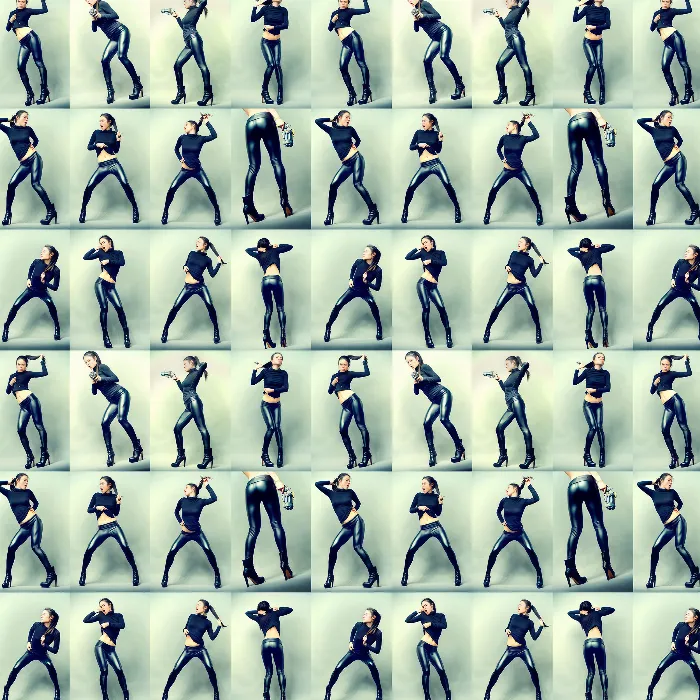4.1 Indoor locations
When I was still a dedicated amateur photographer and didn't have my own studio, my dream was to own one. Or at least to have one available on a regular basis without having to pay expensive studio rental costs for each use. When I rented premises in the summer of 2000 to set up my studio, I couldn't wait to finally get started in my own professionally equipped studio.
But it only took 4 or 5 weeks before I realized that although neutral backgrounds are the best choice for some motifs, they are simply too boring for many other picture ideas. And so I started to fill my studio with (more) suitable props and backgrounds.
Although I now have a background device (with wheels to move it around within the studio), my studio also has several "living" areas with sofas, sideboards, armchairs and other furniture, so that at first glance my studio looks more like an oversized living room with lots of different furnishing styles. But not like a photo studio.
Figure 4.1: The typical black background is ideal for some photos. It is also the first choice for photos in the field of classic nude photography. Nikon D3X with 2.8/105 mm Micro Nikkor. 1/125 second, Blender 7.1, ISO 100.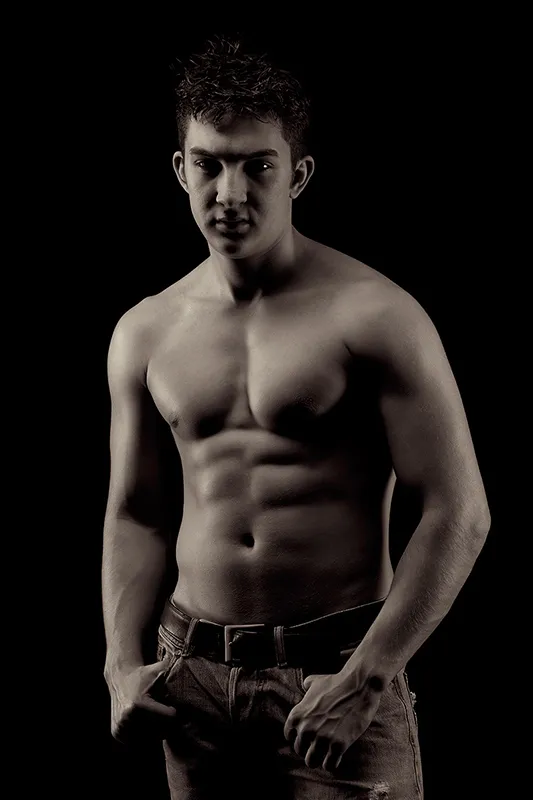
(Photo © 2012: Jens Brüggemann - www.jensbrueggemann.de)
Figure 4.2: This is not the typical white studio background. I often prefer to use a white wall as a white background because the model can then lean against it. This expands the scope for a number of (casual-looking) poses. I also like it when the shadow on the wall is clearly visible. This gives the photo depth (spatiality, three-dimensionality). When shooting in front of a typical (white) studio background, either the shadows are usually flashed away or they look unnatural (due to the curvature of the cove). Nikon D3X with 1.4/85mm Nikkor. 1/125 second, Blender 5, ISO 200.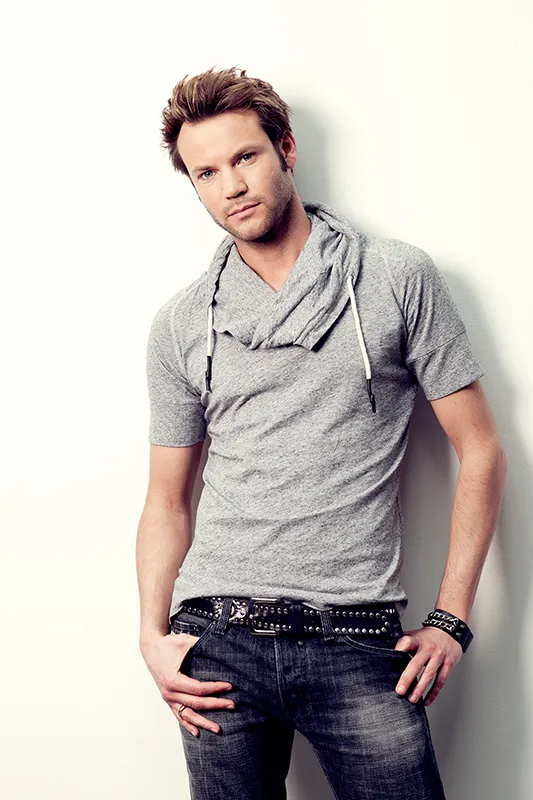
(Photo © 2012: Jens Brüggemann - www.jensbrueggemann.de)
We photographers often think that certain photos can only be taken in a photo studio because that would be the ideal. But quite often you don't even need a studio or the appropriate equipment for the planned shots, just a little space and a small patch of neutral (or sometimes patterned) background.
Figure 4.3: Expressive portraits, unless they are taken as a snapshot or as part of street photography, are best taken in a photo studio. But honestly: what does the photographer really need for portraits like the one shown here? Does a photo like this have to be taken in a studio? Isn't a few square meters in the living room at home enough? Here I have used a dark patterned ceiling as a background. With such a narrow image section, however, not even that would have been necessary. Nikon D4 with 2.8/105mm macro Nikkor. 1/250 second, Blender 13, ISO 100.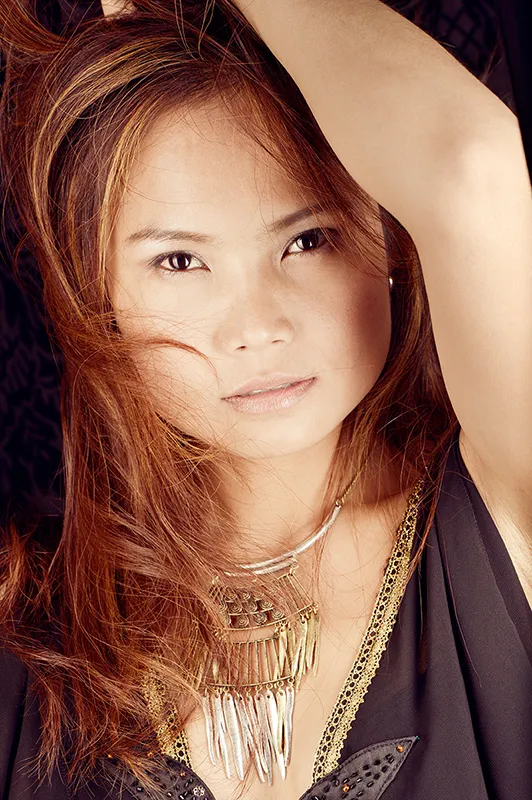
(Photo © 2013: Jens Brüggemann - www.jensbrueggemann.de)
Often enough, it is not even necessary to set up or prepare a background. For example, if you photograph with a (relatively) open Blender, the background recedes visually and does not stand out so much (disturbingly).
Figure 4.4: The chest of drawers in the background is no longer recognizable as such. I find it nicer to recognize some structure in the background than if it were just monochrome (and therefore boring). Nikon D4 with 2.8/70-200mm Nikkor at a focal length of 145 mm. 1/125 second, Blender 4.5, ISO 100.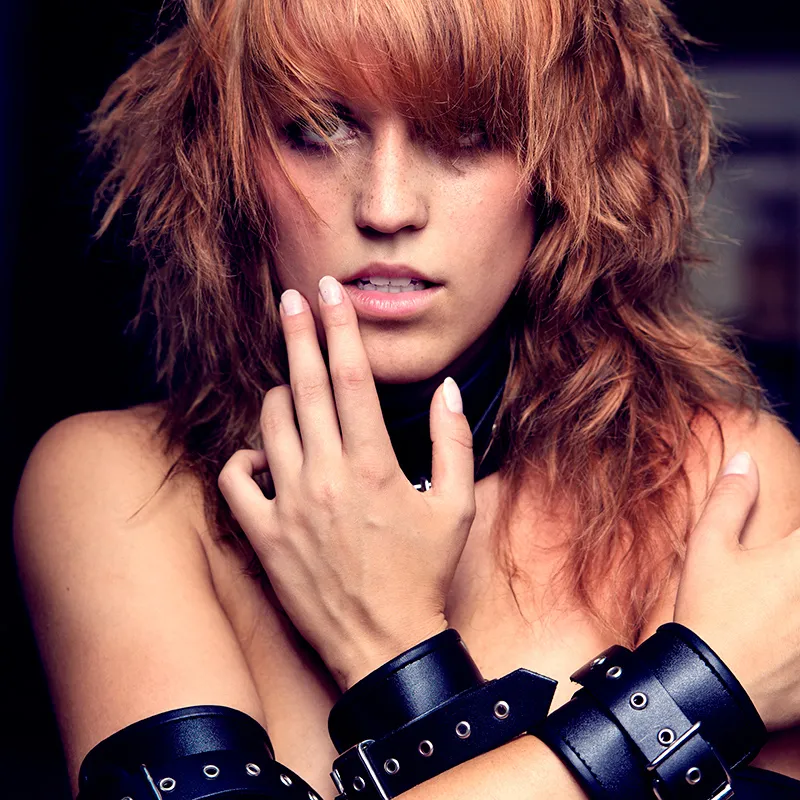
(Photo © 2013: Jens Brüggemann - www.jensbrueggemann.de)
If the background matches the color of the main subject, it is perceived as less disturbing. The inclusion of a natural (homely) background often suits the image idea better than an artificial-looking studio background, for example.
Especially in nude and erotic photography, because the erotic character of the photo is then more credible. Eroticism in a domestic setting is more "logical" than in front of a neutral (studio) background!
Figure 4.5: The model's sexy pose and lascivious look go well with the bathroom ambience. The photos in this series were taken in Prague in a 5-star hotel. I really like working on location because you have different backgrounds available within a very short space of time, even without major conversion phases. You just have to be careful not to bump into anything with the lamp tripods and damage expensive furniture. Nikon D3S with 2.8/105mm Macro Nikkor. 1/80 second, Blender 6.3, ISO 200.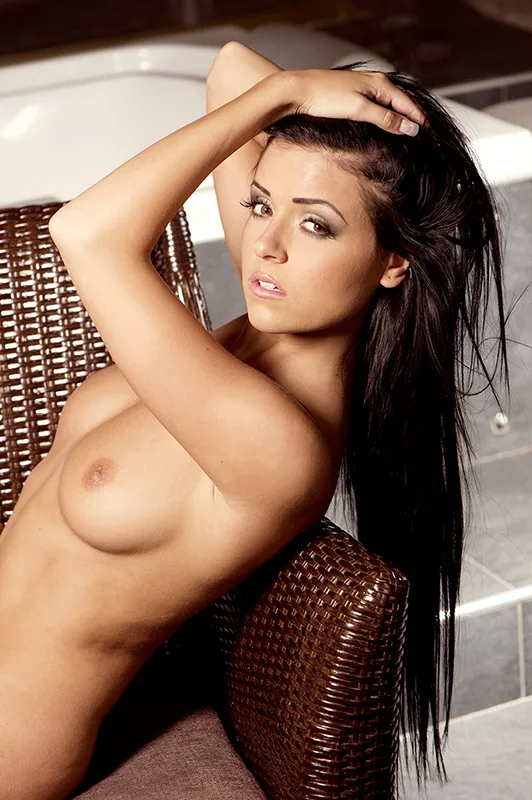
(Photo © 2010: Jens Brüggemann - www.jensbrueggemann.de)
Figure 4.6: Almost every home has a particularly attractive spot that can be used as a background for photos. Here, a fog machine was used in the room behind it so that it recedes visually in the photos and the furnishings do not distract from the model. Nikon D3S with 2.8/24-70mm Nikkor at a focal length of 42mm. 1/250 second, Blender 4.5, ISO 1250..webp?tutkfid=55445)
(Photo © 2010: Jens Brüggemann - www.jensbrueggemann.de)
In almost every home there are corners that are (at least halfway) suitable for photos. This can be a wall niche, a wall projection, a window sill, a door frame, etc. Sometimes, however, the photographer has to move a few things aside (a window box, Blums on window sills, Uropa's urn, etc.) so that not too much clutter disturbs the background. (Depending on the picture idea, this may even be desirable, but usually too much personal clutter is distracting).
Depending on the picture idea, the kitchen can be a particularly suitable location, or an office with a desk (for business portraits), the children's room (when it comes to photographing children and young people) or the bathroom (for example, for erotic photos or beauty portraits on the subject of body care and make-up).
Figure 4.7: In the bathroom, nudity looks natural, not artificial. Ideal for erotic photos! Note, however, that depending on the ambient and water temperature, the water vapors will limit the time available for taking photos to a few minutes. (Unless you can convince the model to strike hot poses despite the cold water ...) Nikon D3S with 2.8/105mm Macro Nikkor. 1/100 second, Blender 5.6, ISO 640.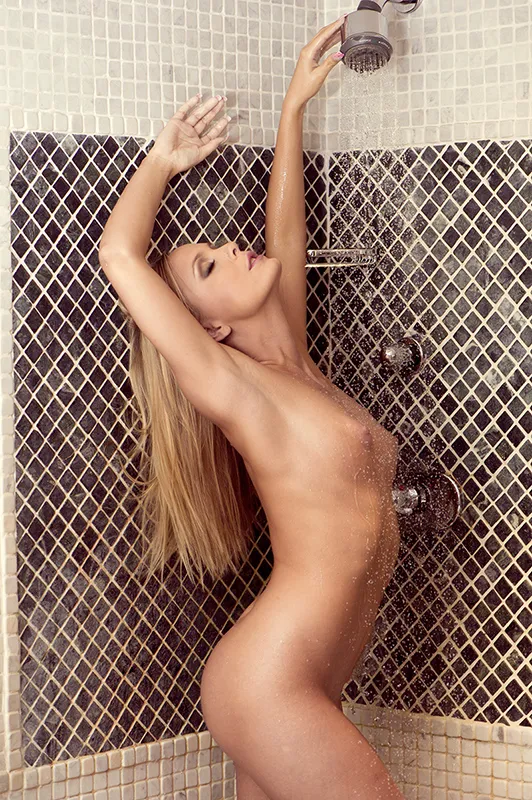
(Photo © 2010: Jens Brüggemann - www.jensbrueggemann.de)
However, it doesn't always have to be rooms that are used for residential purposes. Even and especially (old, dilapidated) industrial halls and ruins can be ideal backdrops for your model photos. Just give it a try!
Figure 4.8: I photographed Micaela Schäfer in 2008 in an old industrial hall in the Duisburg-Nord Landscape Park. However, you need permission to take photos here if you want to publish them. But there are plenty of other empty industrial ruins where you can still take photos without asking (but shouldn't for safety reasons, of course!) Nikon D3 with 2.8/24-70mm Nikkor. 1/125 second, Blender 9, ISO 200.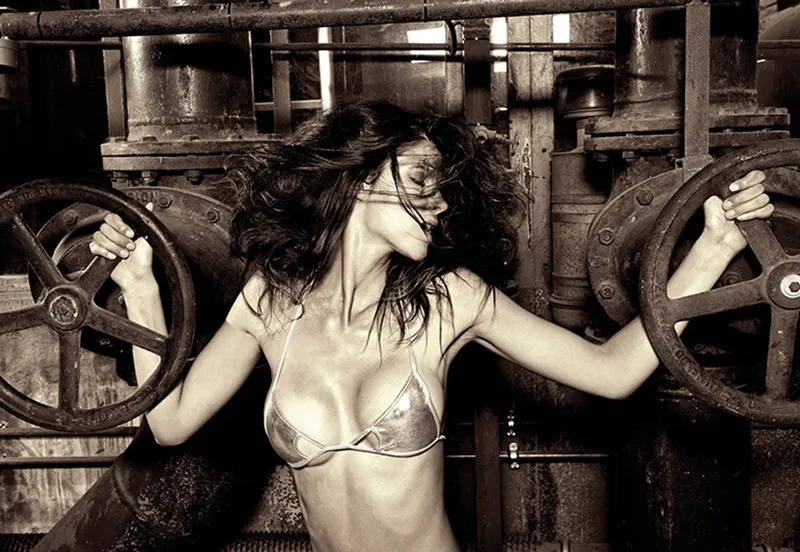
(Photo © 2008: Jens Brüggemann - www.jensbrueggemann.de)
There are many other great locations that cannot all be listed here. Here are just a few examples: Palaces and castles, villas, hotel rooms (ask for written permission to publish! The rental contract for the hotel room only provides for the rental for overnight stays. Everything else is not covered!), old barns and farms, discos and clubs, swimming pools, museums, etc. However, always make sure that you get permission from the owner, preferably in writing! The permission should include both the right to take photos there and the right to use the photos afterwards (including commercially if necessary).
Property release for premises (use free of charge)
By signing this document, the owner/lessee of ............................................ (premises) that the premises of ............................................ (street, house no.), in ............................................ (place) on ............................................ (date) from .......... o'clock to .......... free of charge by the photographer ............................................ and his team for photographic purposes.
The photographs may be used and published by the above-mentioned photographer and third parties without restriction. The above-mentioned photographer undertakes to leave the premises tidy.
............................................
(Signature of photographer)
............................................
(Signature of owner/lessee)
from: "Fotografie und Recht - Die wichtigsten Rechtsfälle für die Fotopraxis" (Kötz/Brüggemann), mitp-Verlag, 2009, 34,95 Euro, ISBN 978-3826659447
Figure 4.9: Photographing in this old barn was (legally) unproblematic. It belongs to an old farmstead somewhere in Andalusia that had been abandoned for years. Nikon D3S with 1.4/85mm Nikkor. 1/160 second, Blender 2.5, ISO 2000.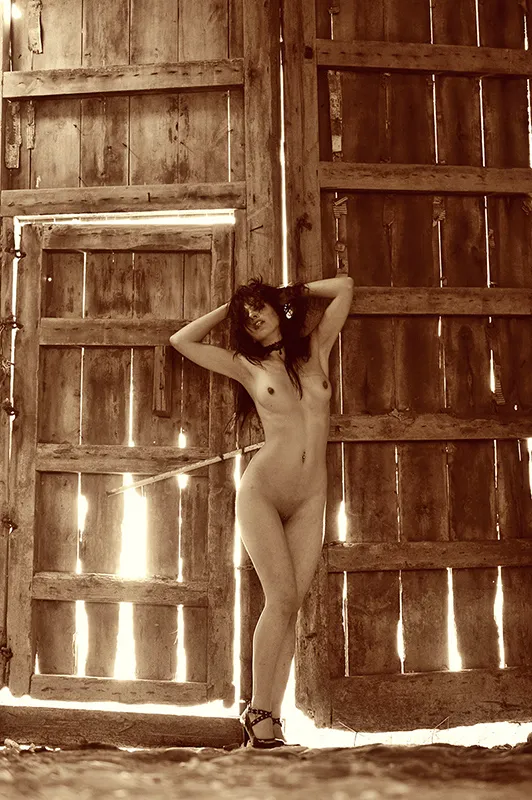
(Photo © 2011: Jens Brüggemann - www.jensbrueggemann.de)
If you want to take photos in a discotheque or club, you should use the existing lighting and effect lights wherever possible. The rooms themselves are often not that spectacular, at least when the lighting is off. In white (day) light, discos and clubs often look really shabby.
You can then clearly see the drink stains on the furniture and floor, the scratches and pen marks on the walls, the cigarette burns in the upholstery, partially broken wooden furniture and counter parts, etc. Everything that is otherwise invisible due to the dim, colorful and rapidly changing lighting is ruthlessly brought to light when you use the flash.
Figure 4.10: I like to take photos in clubs. However, I then only flash lightly; the main light comes from the existing lighting if possible. With the resulting mix of different colors and color temperatures, color casts are largely part of the result. With the help of hue/saturation in Photoshop, the excessive color casts can be softened somewhat. Eliminating them completely would be counterproductive, however, as the club atmosphere should also come across in the photos. Nikon D3 with 2.8/24-70mm Nikkor. 1/125 second, Blender 4.5, ISO 3200.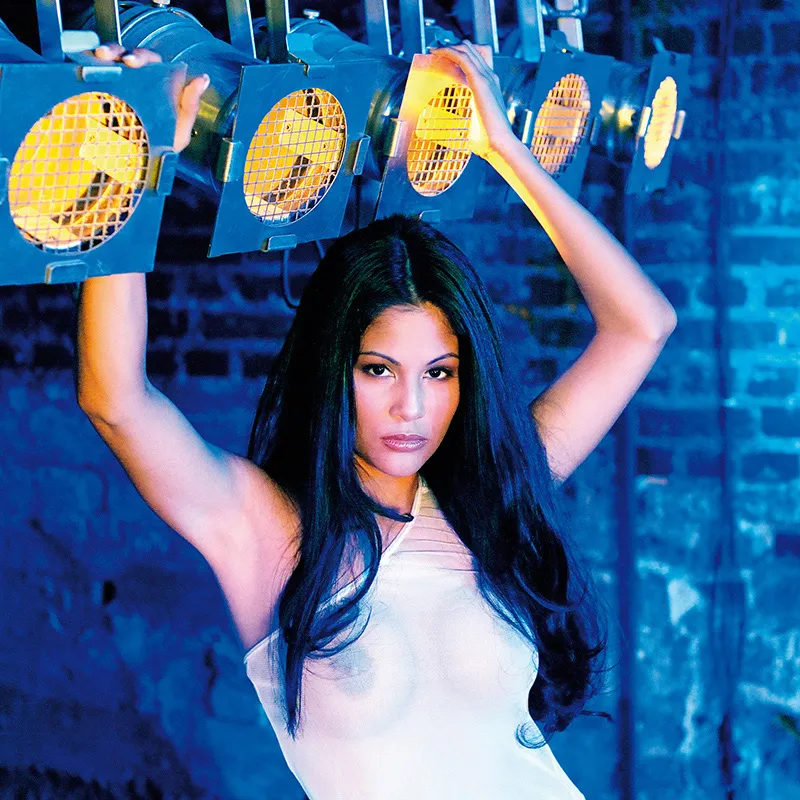
(Photo © 2008: Jens Brüggemann - www.jensbrueggemann.de)
Remark
It is not always necessary to have "special" indoor locations available for the realization of picture ideas. Existing rooms or even just a few square meters of space are often sufficient. Simple means (for example - for portraits - using patterned wrapping paper provisionally stuck to a wall) can also be used to create effective backgrounds.
4.2 Outdoor locations
The choice of location is often of particular importance for the final photographic result. It can also have a strong influence on the image statement. This is especially true for outdoor locations. Reason enough, therefore, to carry out a thorough location search! But how do you find interesting locations that come across as effectively as possible in photos?
Note: If you go location scouting, you should actually do this at least three times a day: in the morning, at midday and late in the afternoon. Whether a location is photographically suitable ("photogenic") also depends to a large extent on the prevailing light mood! The position of the sun (and therefore the shadows) therefore has a significant influence on how the locations "come across" in pictures!
Figure 4.11: I found this great forest while mountain biking. The dress was flashed from behind using a mobile flash unit (Elinchrom Ranger Quadra RX Hybrid) for the translucent effect. I placed a flash head on a lamp stand behind the model, as well as the small generator. The flash was triggered using an Elinchrom "Skyport" radio trigger (which is included with the Ranger Quadra sets).
Unlike the other outdoor generators available on the market, the Ranger Quadra RX is ideal for being transported by the photographer on long walks due to its low weight. Removing the ticks after the photo shoot was more difficult than transporting the equipment and setting up the light ... :-( Nikon D4 with 2.8/14-24mm Nikkor at a focal length of 20mm. 1/60 second, Blender 6.3, ISO 100.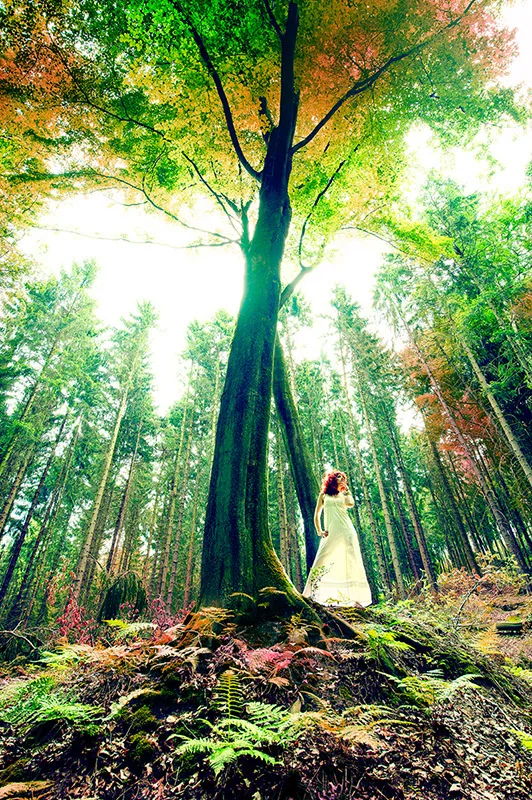
(Photo © 2013: Jens Brüggemann - www.jensbrueggemann.de)
Figure 4.12: Many parks and botanical gardens also invite you to be "discovered" as a location for photos! But be considerate of passers-by to avoid getting into trouble with the operators! It should also go without saying that we photographers should not leave garbage anywhere and should not trample on Blum or other plants. Nikon D3X with 2.8/14-24mm Nikkor. 1/250 second, Blender 22, ISO 125. The photo was flashed with 1,200 watt seconds.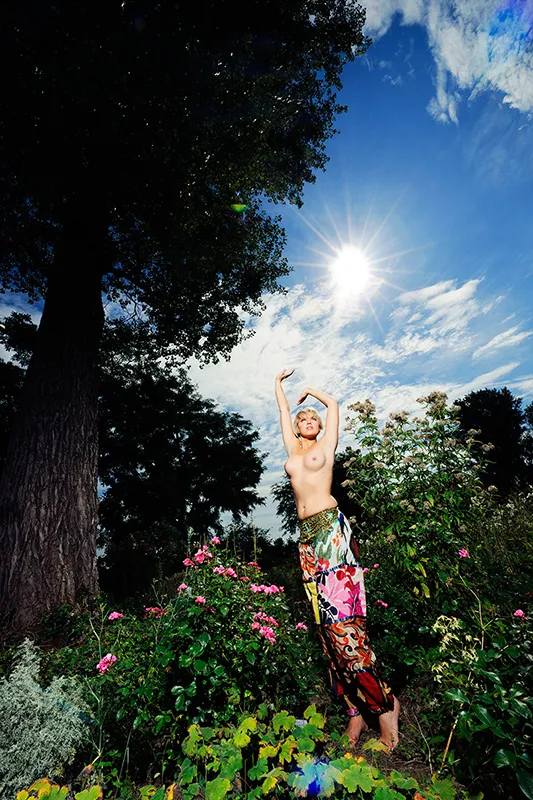
(Photo © 2012: Jens Brüggemann - www.jensbrueggemann.de)
Lighting conditions are often very difficult, especially by the sea. Namely, whenever the sky is blue and cloudless and the sun provides strong, harsh light (and is also responsible for "brutal" shadows). Lucky is the photographer who has brighteners and shading with him (to combat the contrasts). Or can wait until the lighting conditions change and a hazy sky provides soft, pleasant light.
Figure 4.13: I was lucky here: the cloudy sky provided perfect light, which was easy to handle even without lighting aids. Nikon 1 J1 with 3.5-5.6/10-30mm Nikkor. 1/640 second, Blender 6.3, ISO 100.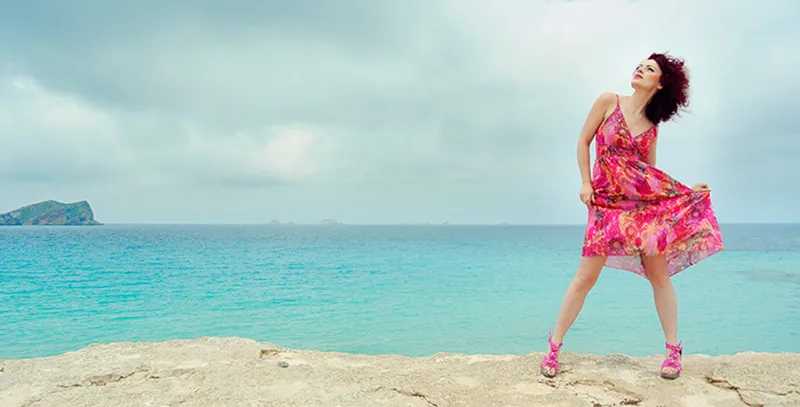
(Photo © 2013: Jens Brüggemann - www.jensbrueggemann.de)
Figure 4.14: Ibiza is my favorite island, because there are many great "photogenic" locations there. In addition to the beach and palm trees, there are also beautiful reddish rocks that harmonize very well with many model photos. That's why I've been flying to Ibiza several times a year for photo shoots for the past 9 years. My next photo workshop will take place there from May 12 to 19, 2014 (topics: erotic, beauty and fashion photography). In order to set the light professionally, I will also be bringing brighteners and shades from California Sunbounce and a mobile generator from Elinchrom (Ranger Quadra RX Hybrid) for the participants to use. Nikon D3X with 2.8/14-24mm Nikkor. 1/200 second, Blender 22, ISO 100.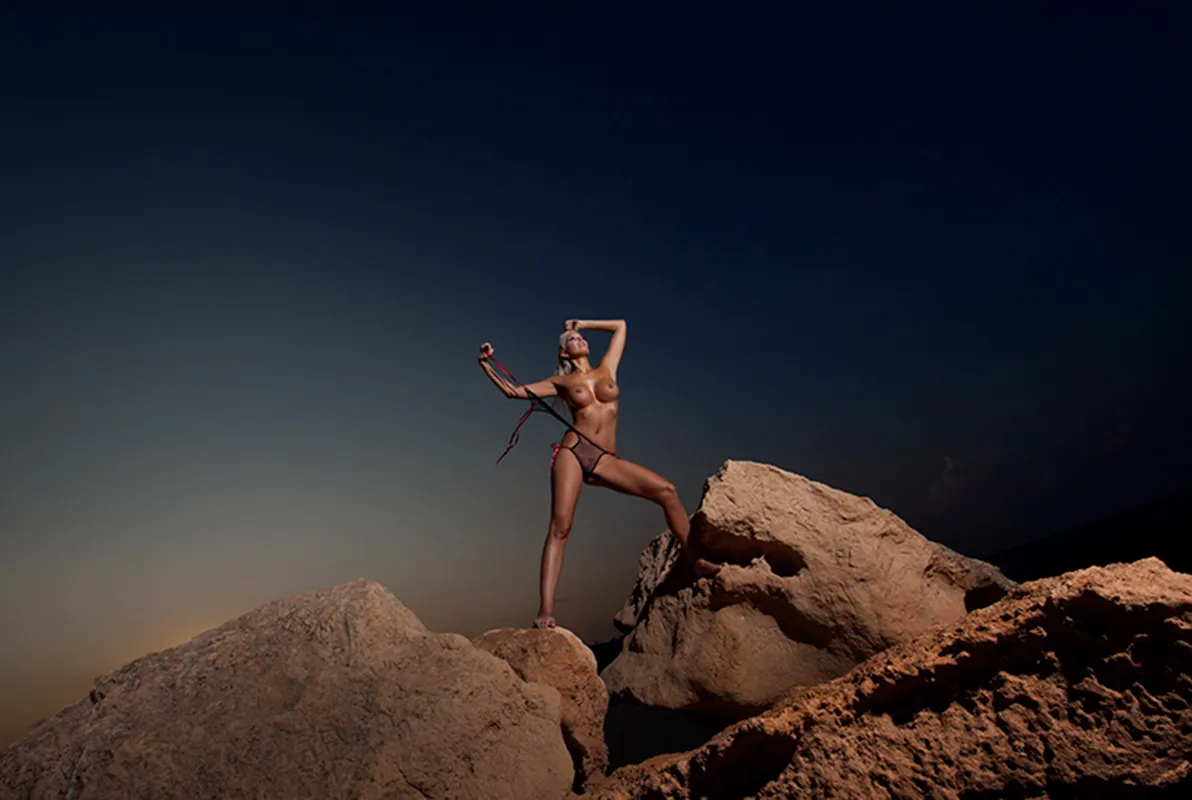
(Photo © 2011: Jens Brüggemann - www.jensbrueggemann.de)
Figure 4.15: Dilapidated historic castles are a great backdrop for unusual model photos. This famous Moorish fortress is also one of the locations for my one-week Andalusia workshops, which take place every year in October.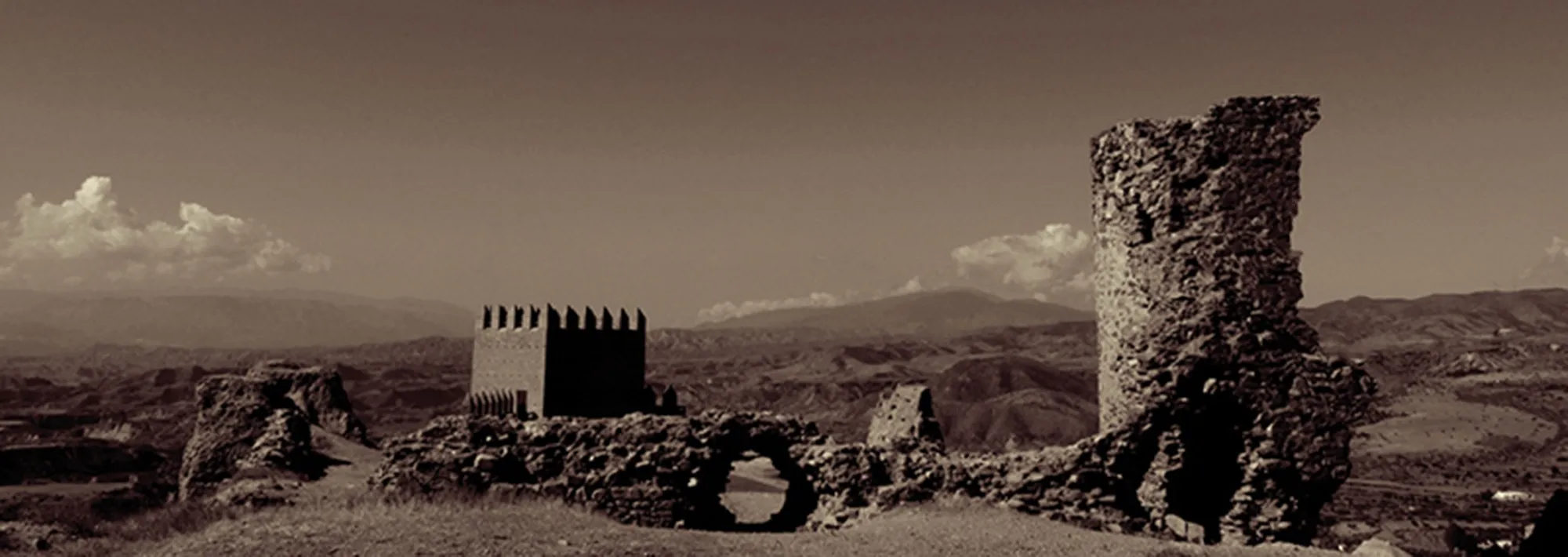
(Photo ©: Jens Brüggemann - www.jensbrueggemann.de)
While in Germany all the old ruined walls have either been fenced off, repaired or even demolished for safety reasons, people are more relaxed abroad. I know some great (dilapidated) locations in Spain that are freely accessible, which would be unthinkable in Germany. However, I wouldn't do anything that could be dangerous in any way during my photo shoots or photo workshops. Locations such as the Moorish fortress pictured above are objectively no more dangerous than rock formations on the beach, for example.
Rocks with lots of loose small stones are treacherous because you can slip very quickly. That's why sturdy, stable shoes are part of the equipment on all my workshops abroad.
Figure 4.16: You don't have to fly all the way to the USA to find a location like in a western movie. A number of feature films have been shot here in Andalusia, such as "Indiana Jones", "Manitou's Shoe", "Lawrence of Arabia", "Four Fists for a Hallelujah", "For a Fistful of Dollars More" and almost all Sergio Leon films.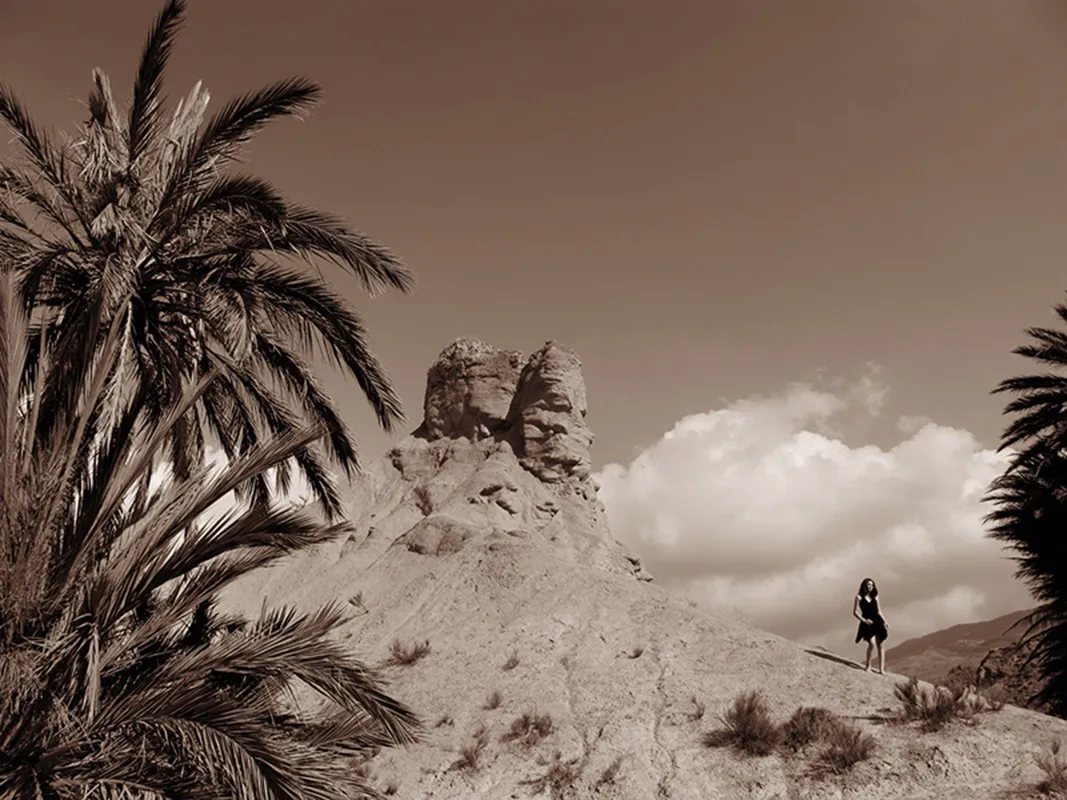
(Photo ©: Jens Brüggemann - www.jensbrueggemann.de)
If you are looking for interesting, "photogenic" locations, you won't always find them in the travel guide. A typical "postcard idyll" is not necessarily suitable for photos as a background. Ideal locations are characterized by depth, an interesting light-shadow gradient, the presence of structures in the landscape, and colour also plays a major role in their suitability.
In my opinion, the parched earth of Ibiza and Andalusia with its yellow-brown-reddish earth tones comes across better in model photos than the lush green of the meadows in Germany, for example.
Depending on the image idea, urban locations are also interesting for photos, especially in fashion photography. Cityscapes are therefore also popular locations in fashion photography. But here, too, the monochrome colors of the concrete certainly play a not insignificant role in their suitability.
Note: There are many "beautiful" landscapes that I love to look at, but which I don't find interesting enough for photos. I don't usually consider entire views to be suitable, but rather small sections of landscapes. I think it's more important that the model can be integrated into the background; that I can work with the spatiality, i.e. that I have both foreground and background.
Figure 4.17: Depending on the image statement, concrete may be more suitable as a background than a green meadow. The colors of the clothing also play a role, as they should match the colors of the location. Nikon D3S with 2/200mm Nikkor. 1/640 second, Blender 4, ISO 200.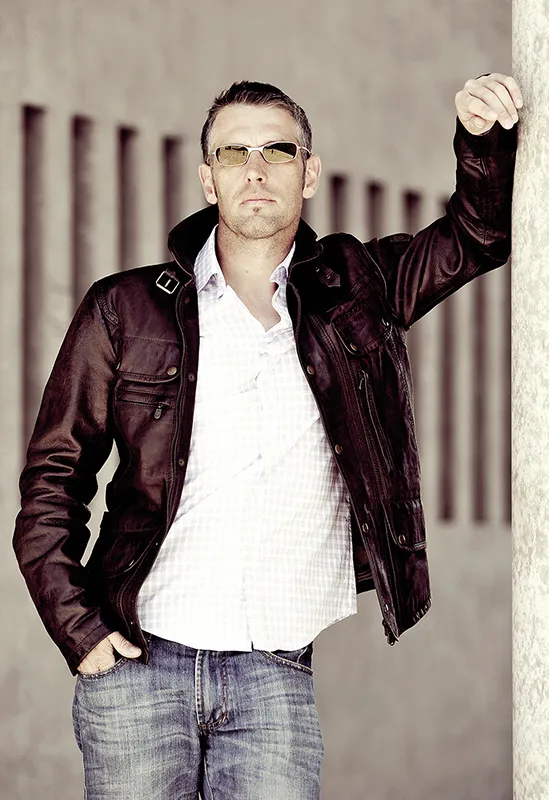
(Photo © 2011: Jens Brüggemann - www.jensbrueggemann.de)
Note
"Often it is rather inconspicuous locations that are particularly suitable for photos - but which "normal" people simply pass by without discovering the potential. So keep your eyes open and imagine what you can make out of the given circumstances with clever framing, lighting and other camera techniques! If you have this "photographic vision", you will never run out of locations!"
From: "Modelfotografie - Profiwissen Beauty-, Fashion- und Erotikfotografie" (Jens Brüggemann), mitp-Verlag, 2013, 39,95 Euro, ISBN 978-3-8266-9212-3
